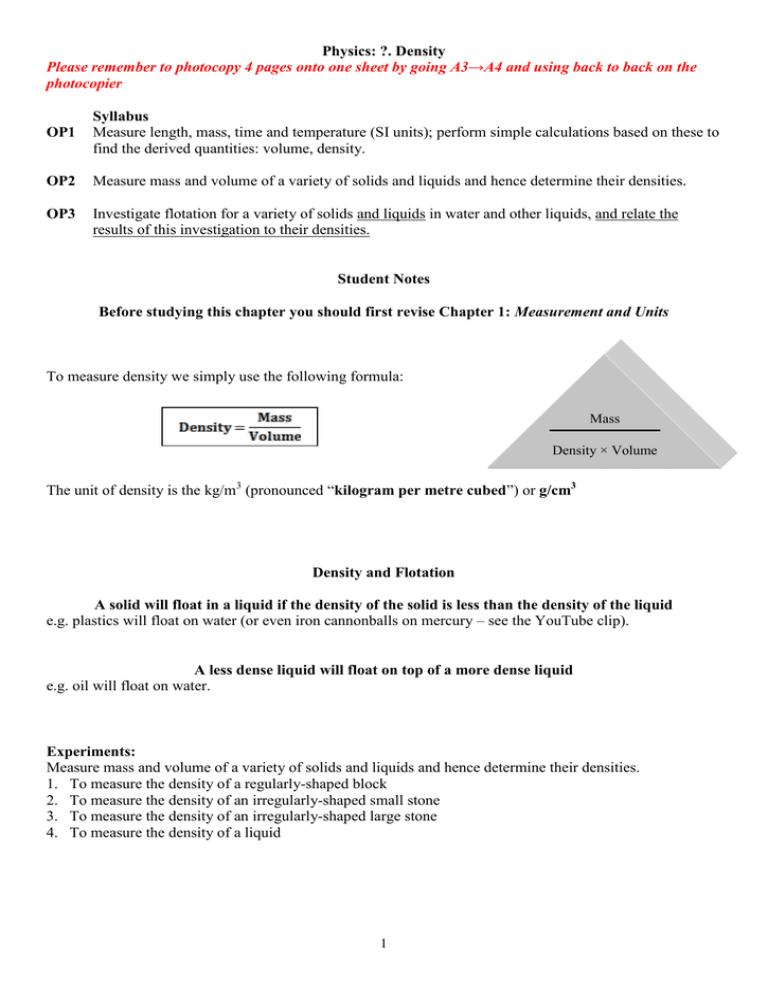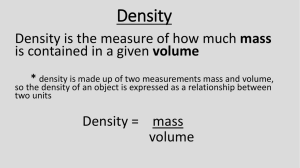Physics: ?. Density Please remember to photocopy 4 pages onto
advertisement

Physics: ?. Density Please remember to photocopy 4 pages onto one sheet by going A3→A4 and using back to back on the photocopier OP1 Syllabus Measure length, mass, time and temperature (SI units); perform simple calculations based on these to find the derived quantities: volume, density. OP2 Measure mass and volume of a variety of solids and liquids and hence determine their densities. OP3 Investigate flotation for a variety of solids and liquids in water and other liquids, and relate the results of this investigation to their densities. Student Notes Before studying this chapter you should first revise Chapter 1: Measurement and Units To measure density we simply use the following formula: Mass Density × Volume The unit of density is the kg/m3 (pronounced “kilogram per metre cubed”) or g/cm3 Density and Flotation A solid will float in a liquid if the density of the solid is less than the density of the liquid e.g. plastics will float on water (or even iron cannonballs on mercury – see the YouTube clip). A less dense liquid will float on top of a more dense liquid e.g. oil will float on water. Experiments: Measure mass and volume of a variety of solids and liquids and hence determine their densities. 1. To measure the density of a regularly-shaped block 2. To measure the density of an irregularly-shaped small stone 3. To measure the density of an irregularly-shaped large stone 4. To measure the density of a liquid 1 Summary of all the experiments In each case to calculate the density we simply use the formula: To measure the density of a regularly-shaped block To find the mass - weigh it on an electronic balance. To find the volume: Volume = length × width × height In this case the volume is 5 × 2 × 1 = 10 cm3. To measure the density of an irregularly-shaped small stone To find the mass - weigh it on an electronic balance. To find the volume: Drop the stone into a graduated cylinder containing water and note the new volume. To get the volume of the stone simply subtract the two readings. In this case the volume = 90 – 75 = 15 cm3. To measure the density of an irregularly-shaped large stone To find the mass - weigh it on an electronic balance. To find the volume: Fill an overflow can up to the top and place an empty graduated cylinder under the spout. Carefully drop the stone in (using a string so there is no splash). Note the level of water in the overflow can. To measure the density of a liquid To find the mass: Weigh an empty graduated cylinder, and then weigh the graduated cylinder after pouring water into it. Then subtract the two readings. To find the volume simply note the level of water in the graduated cylinder. 2 Exam Questions: 1. [2008 OL] (i) Complete the equation in the box below using the words on the right. Density = (ii) If the mass of a stone is 20 g and the volume of the stone is 10 cm3, find the density of the stone. 2. [2007 OL] A block of metal has the measurements shown on the right. The mass of the metal block is 21 g. (i) Calculate the volume of the block. (ii) Calculate the density of the block. 3. [2011 OL] A student set up the equipment shown to measure the volume of an irregular shaped object e.g. a stone. When the stone was carefully dropped into the graduated cylinder containing water, arrangement B resulted. (i) Calculated the volume of the stone from the information shown. (ii) If the mass of the stone was 40 g, calculate the density of the stone. (iii)What is the unit of density? 4. [2009 OL] The mass of a metal block is 14.7 g. It has a volume of 7 cm3. (i) Name the instrument you would use in the laboratory to find the mass of the block. (ii) Calculate the density of the block. (iii)What is the unit of density? 5. [2009] A pupil measured the volume of a potato using the items of laboratory equipment, labelled A and B as shown in the diagram. (i) Name the items labelled A and B. (ii) The potato had mass 175 g and volume 125 cm3. Calculate the density of the potato. Give the units of density with your answer. (iii)Why did the potato sink in the water? 5. [2011] The photo shows a hot air balloon. Why does the balloon rise when the air inside is heated? 6. [2010] Why do icebergs float on water? 7. [2007] Ice floats on water but ice sinks in ethanol (an alcohol). Use this information to compare the density of ice with (i) the density of water; (ii) the density of ethanol. 3 MASS VOLUME Exam Solutions 1. (i) Density = Mass/Volume (ii) Density of the stone = 20/10 = 2 g/cm3 2. (i) Volume = 5×1×2 = 10 cm3 (ii) Density = 21/10 = 2.1 g/cm3 3. (i) Volume = 90 – 70 = 20 cm3 (ii) Density = mass/volume = 40/20 = 2 g/cm3 (iii)g/cm3 4. (i) Electronic balance / weighing scales (ii) Density = 14.7÷7 = 2.1 (iii)Unit = g/cm3 5. (i) Item A is an overflow can Item B is a graduated cylinder (ii) Density = 175/125 = 1.4 g/cm3 (iii)Because it is denser than water 6. Because the air expands and becomes less dense / air outside denser 7. They have a lower density than water. 8. (i) Ice is less dense than water (ii) Ice is more dense than ethanol Extra Questions: Density 1. What is meant by the term ‘density’? 2. Draw a diagram of the apparatus used to measure the density of a regularly-shaped object. 3. Draw a diagram of the apparatus used to measure the density of an irregular-shaped object. 4. Draw a diagram of the apparatus used to measure the density of a liquid. 5. A stone has a mass of 120 g and a volume of 20 cm3, what is the density of the stone? 6. What is the density of an object which has a mass of 20 kg and whose volume is 4 m3? 7. A student measured the density of a number of substances. The results are shown in the table below. Identify two substances that would float in paraffin oil. Substance Cork Polystyrene Water Paraffin Oil Rubber Density (g/cm3) 0.3 0.03 1.0 0.7 1.1 4






